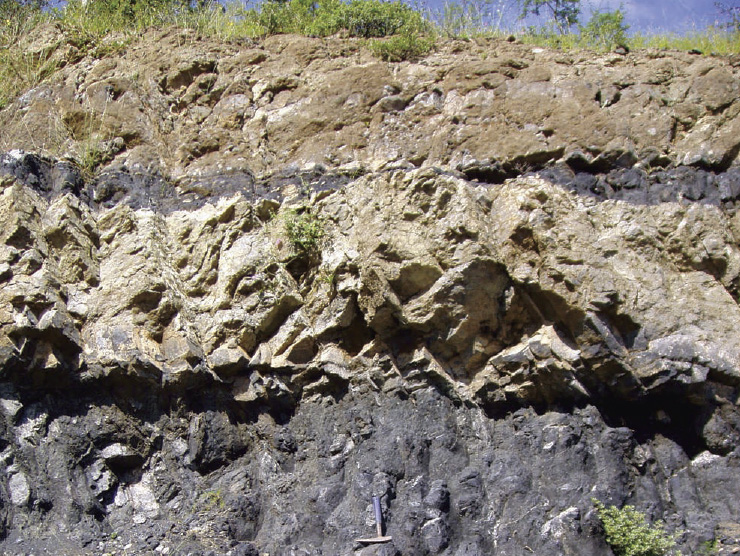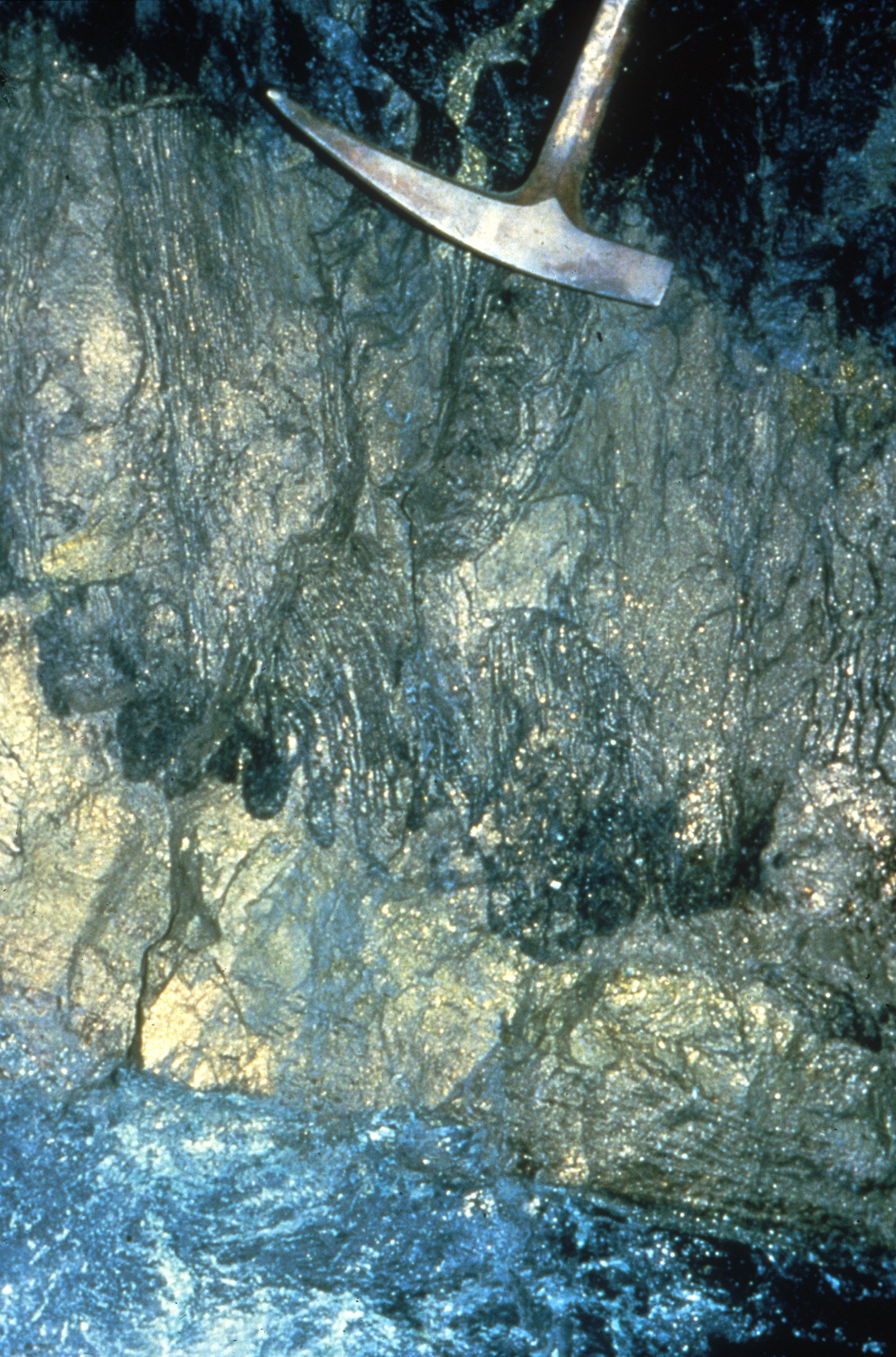The potential of a property can be a hard thing to access during the early stages of exploration. Working in under-explored areas offers the promise of making a major discovery, at the cost of high degrees of uncertainty, and, more often than not, a long, winding road to success. Delta Resources is experiencing this firsthand right now as their exciting, surprising discovery of high-grade gold hints at potential few would have guessed from the area.
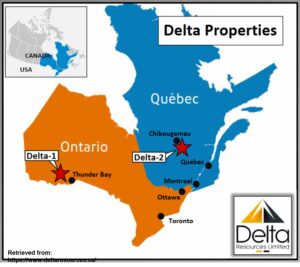
The Delta 1 Property
Delta Resource’s (TSX.V: DLTA) flagship gold (Au) property is located 50 km west of the city of Thunder Bay, Ontario, Canada. The property enjoys excellent road and infrastructure access, being situated near a small city and immediately adjacent to the Trans-Canada Highway and a major power line. Delta 1 is at an early stage of exploration; no resource estimate is available, and there is no mining or processing infrastructure on the property.
Historic exploration on the property has been very limited, with only 42 drill holes, 20 of which targeted magmatic nickel (Ni)-copper (Cu) mineralization, completed prior to Delta’s acquisition of the property. Trenching carried out by Delta since 2019 has revealed a gold-bearing vein system extending over >2 km. Modest drill programs (23 holes from 2021-2022) have delineated a mineralized corridor with many lengthy but low grade (~0.3-0.5 g/t over 50-110 m) intercepts, as well as occasional shorter intermediate to high-grade (~1-10 g/t over 1-2 m) intercepts.
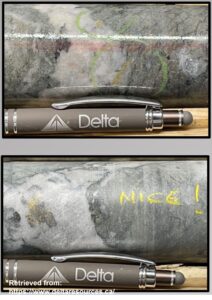
In late 2022, however, a single hole probing the newly discovered Eureka zone, D1-22-18, returned an eye-popping intercept of 5.92 g/t Au over 31 meters, including 14.8 g/t over 11.9 m and 72.95 g/t over 2.2 m. The intercept was so long, in fact, that the hole ended in 1.34 g/t, and had to be extended as part of a supplementary drill program. This supplementary program also included two more drill holes at 50- and 100-meter step-outs from hole D1-22-18. Assay results extended the mineralized zone in hole D1-22-18 slightly, while assays from the other two holes are still pending. Eureka has a strike length of at least 950 m, extends from surface to at least 250 m depth, and is open in all directions.
A new 5000 m drill program aimed at extending the Eureka Gold zone and investigating similar targets commenced on Jan. 17, 2023.
The Delta 2 Property
Delta Resource’s other property is located 35 Km southeast of Chibougamau Quebec, Canada. The property enjoys excellent access to road, rail, and power infrastructure. Delta 2 is a polymetallic project focused on Au and Cu-Au mineralization. The property is just 1.5 km south of the historic Lemoine Mine, which produced 0.76Mt at 4.2% Cu, 9.6% zinc (Zn), 4.5 g/t Au and 83 g/t silver (Ag) from extremely high-grade Volcanic-hosted Massive Sulfide (VMS) style mineralization from 1975-1983.
There are two distinct types of mineralization on the property: high-grade gold associated with structures related to large intrusions, and VMS style Cu-Au targets associated with volcanic rocks. Drilling has returned intercepts as high as 18.9 g/t Au over 2.5 m, including 50.75 g/t over 0.9 m. No resource estimate is available for the property.
Delta 1 Geology
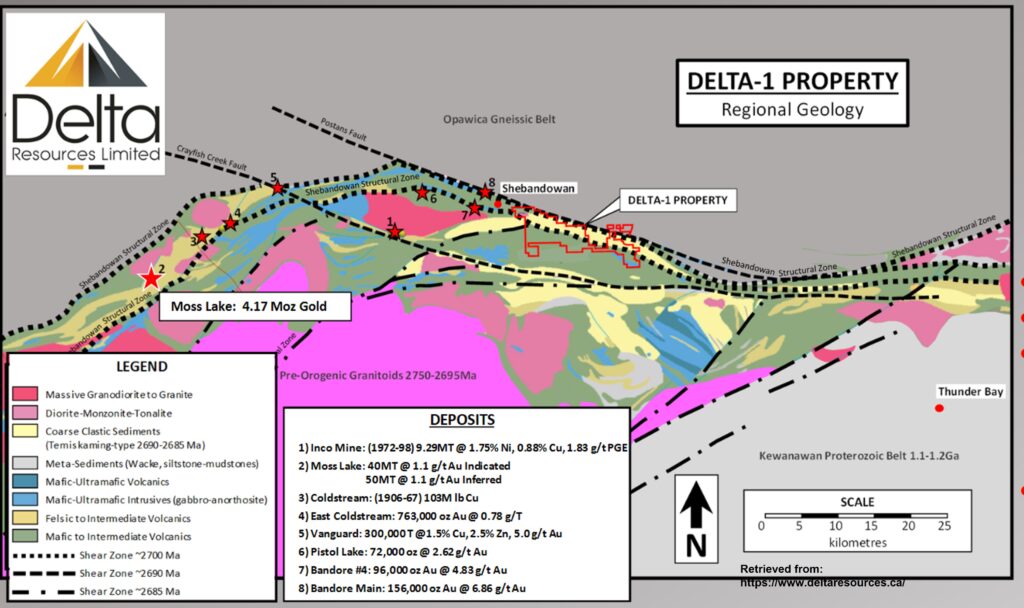
Delta 1 is Located in the Shebandowan Shear Zone within the Shebandowan Greenstone Belt. Gold mineralization on the property is associated with the contact between ~2.7-billion-year-old conglomerates and slightly older ultramafic-intermediate volcanic rocks. This setting is similar to that of gold deposits in the prolific Abitibi Greenstone belt. Several types of mineralization including orogenic gold, VMS, and magmatic Ni-Cu have been described in the area. Historically, Ni, Au, Cu and Ag have been produced from magmatic and VMS deposits in the region.
Gold mineralization in Delta 1 is hosted in chert (quartz) and chert-breccia units, graphitic shear zones, and associated carbonate alteration zones. This mineralization is strongly associated with a large intermediate dyke. Gold in the Eureka Gold zone is found together with pyrite and arsenopyrite in quartz-carbonate veins within a large zone of calcite-ankerite (calcium and iron-magnesium carbonate) alteration.
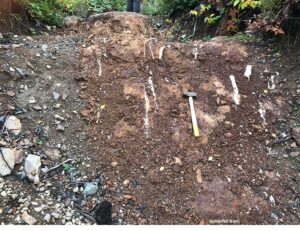
Although VMS and magmatic Ni-Cu deposits often have low-moderate gold grades, these deposits contain massive sulfides, which are absent on the Delta 1 property. Orogenic gold is by far the most likely model to explain gold mineralization at Delta 1. Orogenic deposits form when mafic rocks are metamorphosed under low-moderate temperatures and pressures during ancient mountain-building (orogenic) events. Under these conditions metamorphic fluids may leach gold from large volumes of rock and form gold-bearing quartz-carbonate veins, which are often found near major fault or shear zones.
Delta 2 Geology
Delta 2 is hosted in the northeast end of the prolific Abitibi Greenstone Belt, near the Chibougamau and Chapais mining camps which account for historic production of 47.5 Mt at 1.72% Cu, 2.30 g/t Au and 24.2 Mt at 2.24% Cu, 1.13 g/t Au, respectively. Rocks in the area consist mainly of 2.7-2.8-billion-year-old mafic volcanics, which are extensively intruded by a variety of igneous rocks.
The region is quite geologically complex, with Cu-Au-Zn VMS mineralization in the area associated with the boundary between different types of volcanic rocks. VMS deposits form from volcanic vents releasing metal-rich fluids along ancient seafloors, and typically form in clusters with several relatively small deposits flanking a much larger one. Oddly, the high-grade, low-tonnage Lemoine Deposit is the only one known in the immediate area around Delta 2, suggesting more deposits may remain to be found. So far Delta’s exploration efforts have turned up only traces of VMS mineralization.
High-grade Au deposits in the area are associated with structures related to later igneous intrusions, suggesting they are intrusion-related Au deposits. These typically form when gold-bearing fluids are released from cooling intrusions to form Au-bearing quartz-carbonate veins nearby.
Analysis: Mother Lode or Red Herring?
The assays results from D1-22-18 in the Delta 1 project are truly impressive: such high grades over such long intercepts are rarely seen outside of the world’s richest gold camps. The fact these come from within a few hundred meters of surface makes them even sweeter. These exceptional results are also quite surprising; the region has historically been more known for producing bases metals, and previously discovered gold mineralization in the area has been low-grade. Even Delta’s previous surface and drilling results from the same property have been nothing comparable to their most recent results. The billion-dollar question is whether these results are a one-off fluke or the start of a major discovery.
Unfortunately, this question is very difficult to answer with the available information. There is relatively little detailed geologic information publicly available, and no less than three different deposit models could be applied to the area. The orogenic model most easily explains the high gold grades, however bonanza grades can sometimes be the result of hydrothermal upgrading long after the deposit’s formation, in which case they may be more of an anomaly than reflective of the deposit as a whole. The results of the two remaining holes will provide some indication: if either or both come back with intercepts half as good as D1-22-18 then Delta 1 could well be on the fast track to becoming the next big mine. If they return low grade or no gold at all it could mean either D1-22-18 was just a fluke, or the deposit is structurally complex, as is common for orogenic deposits, and finding more high-grade gold may require a great deal more drilling.
It is interesting that D1-22-18 had to be extended. No competent geologist would intentionally stop drilling in mineralization. It is possible that factors beyond their control (mechanical failure, approaching wildfire, etc.) could have forced an early shut-down, but it’s also possible that the continuing mineralization simply wasn’t recognized. Gold isn’t always easy to spot with the naked eye, especially when you don’t know exactly what to look for. Delta’s website also compares the Delta 1 project to Goldshore Resources’ relatively nearby low-grade, high-tonnage Moss Lake deposit (122 Mt at 1.1 g/t), which suggests that, until quite recently, they were looking for something very different than what D1-22-18 suggests.
Considering how little gold exploration has been carried out in the region it’s not surprising that Delta might not know exactly what it’s got or what it should be looking for. Most companies need a few years to really figure out a property and gold, especially orogenic gold, has a reputation for being difficult. It’s important to remember that Delta Resources is still a small company; fully exploring Delta 1 will almost certainly require some combination of time, significant expansion, and taking on partners with significant resources.
For its’ part, Delta appears quite confident. The 50 and 100 m step-outs on D1-22-18 are very aggressive, many companies would’ve opted for half this distance, if not less, so as to increase the chances of generating another spectacular intercept. Either Delta has good reason to be confident the gold is there, or they’re not afraid to swing for the fences.
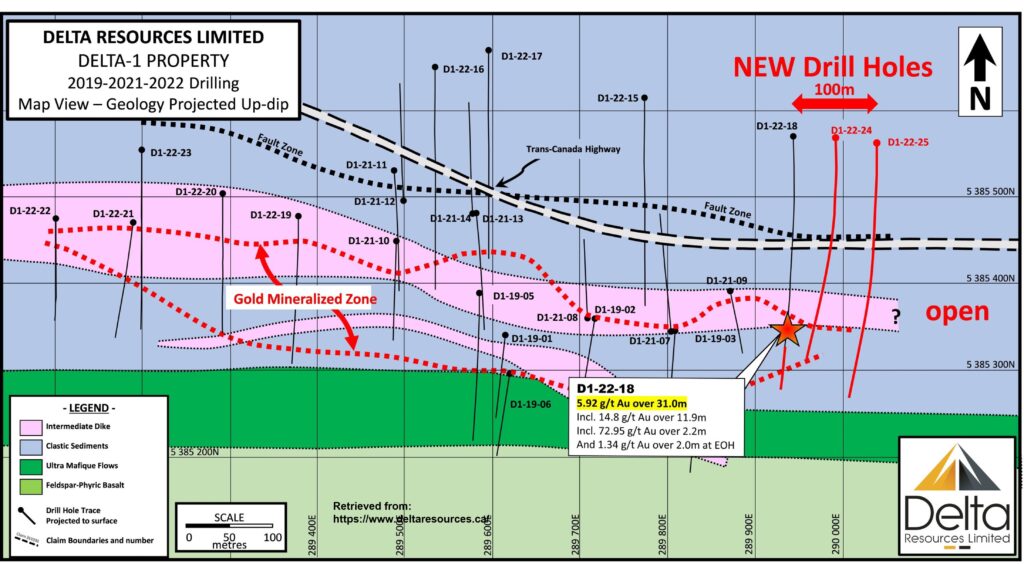
Even if these recent spectacular results can’t be replicated both the Delta 1 and Delta 2 properties have yielded some solid results and could become successful projects. Unimpressive results from the follow-up holes would be disappointing, but far from fatal for Delta Resources.
Investor Takeaways
Delta Resources has two promising early-stage projects, Delta 1 and Delta 2. Remarkable gold grades over impressive intervals suggest Delta 1 has the potential to become a world-class high-grade, high-tonnage deposit, but it’s important not to get carried away just yet. A single drill hole doesn’t make a deposit, and there’s still a great deal we don’t know about the Delta 1 property. Finding the deposit’s true potential will likely take years, and even if all goes well Delta Resources is nowhere near opening a mine. For the short-term though, there’s every reason to think Delta Resources has some exciting times ahead.
List of Companies Mentioned
- Delta Resources: https://www.deltaresources.ca (website)
- Goldshore Resources: https://goldshoreresources.com (website)

